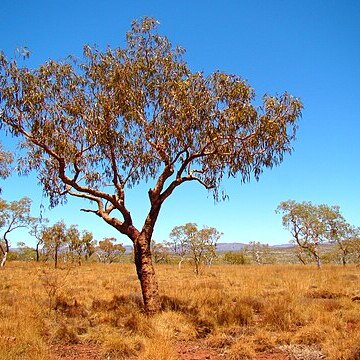Tree to 18 m tall, or rarely a mallee. Forming a lignotuber. Bark rough on part or all of trunk, sometimes extending to the larger branches but not uncommonly on lower trunk only, tessellated, light brown to light grey or, where flakes have recently shed, reddish, pink or orange; bark of larger limbs may be rough or smooth; smooth bark whitish or cream. Juvenile growth (coppice or field seedlings to 50 cm): stems rounded in cross-section, setose in early stages; juvenile leaves opposite and petiolate for many pairs, ovate to elliptical to lanceolate, 6–17 cm long, 1.2–4.5(5.2) cm wide, base tapering to petiole, apex rounded on lowest leaves, becoming acute higher up stem, margin subcrenulate on lowest leaves then entire, slightly discolorous, green to grey-green, usually glabrous, even lower leaves. Adult leaves alternate, petiole 1–3 cm long; blade lanceolate, 8–20 cm long, 1.2–3 cm wide, base usually tapering to petiole, concolorous, slightly glossy or dull, pale green to yellowish green, strongly penniveined, very densely reticulate, intramarginal vein absent, oil glands few and island, or absent. Inflorescence terminal compound, peduncles 0.5–2 cm long, buds 7 per umbel, pedicels 0.2–1.3 cm long. Mature buds ovoid to pyriform, 0.6–1.4(1.7) cm long, 0.5–1(1.3) cm wide, greenish to brown or cream, scurfy, scar absent (both opercula shed together at flowering), operculum shallowly conical to rounded or flattened, stamens inflexed, anthers oblong, versatile, dorsifixed, dehiscing by longitudinal slits (non-confluent), style long, stigma slightly mop-like, locules usually 4, the ovules not arranged in distinct vertical rows on the placentae. Flowers white, very rarely pink. Fruit pedicellate (pedicels 0.2–1.2 cm wide), urceolate, (1.3)1.5–3.1 cm long, 1.2–2.2 cm wide, disc vertically descending, valves, usually 4, enclosed. Seeds light brown or reddish brown, ellipsoidal with terminal membraneous wing, 9–12 mm long (including wing), surface smooth, hilum subterminal. Cultivated seedlings (measured at node 10): cotyledons reniform; stems round in cross-section, slightly scabrid on the lower stem then smooth, leaves petiolate (shortly petiolate on lower leaves), opposite to sub-opposite becoming alternate at ca node 12, lanceolate to narrowly lanceolate, occasionally oblong to elliptical, 4–15.5 cm long, 1–2.8(3.5) cm wide, base rounded or tapering, dull grey to grey-green, apex acute to apiculate to occasionally rounded, setae sparse on lowest two leaf pairs then glabrous.
More
Tree or shrub to 12 m. Bark tessellated throughout, orange-grey, grey-red, or red-brown. Juvenile leaves not seen. Adult leaves subopposite or alternate, lanceolate, falcate, acute or acuminate, thick; lamina 8–14 cm long, 1–2.6 cm wide, grey-green, concolorous; lateral veins faint, at 60°–70°; intramarginal vein confluent with margin; petiole 10–25 mm long. Umbels 3–7-flowered; peduncle 8–12 mm long; pedicels 4–8 mm long. Buds pyriform; operculum hemispherical-conical, 2–4 mm long, 3–5 mm wide; hypanthium truncate-pyriform or suburceolate, 2–4 mm long, 3–5 mm wide. Fruits globose or ovoid, rarely with a short neck, 15–25 mm long, 20–25 mm wide, sometimes faintly ribbed. Seeds with a long terminal wing, yellow-brown.
A small tree. It grows 10 m high. It often has several stems. The bark is mottled and rusty or brown. It is scaly. The leaves are pale and yellowish-green. They are pointed at the tip. The buds are cream coloured and 1 cm long. They occur in clusters at the ends of stems. The flowers are cream. They can be pink in the centre. The capsules are urn shaped with thick rims. They have 4 deeply enclosed valves.


